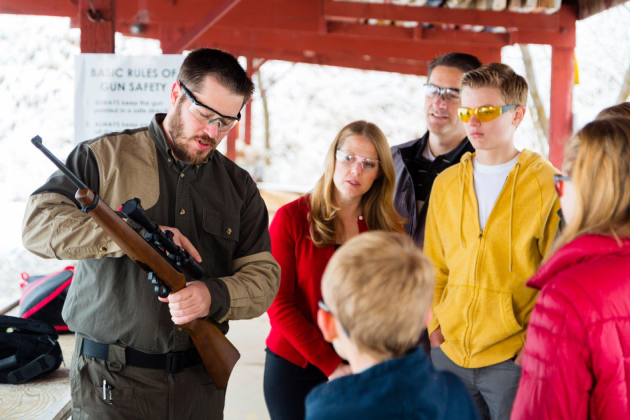With the sport of hunting gradually increasing in popularity around the United States each year, hunters are finding themselves in closer proximity to other hunters than ever. Naturally, this situation creates a certain element of danger, considering the minuscule amount of safety training required for a hunting permit, and that fact that nearly every hunter in America is walking around with a loaded firearm.
Here are a few basic tips to keep you and others as safe as possible while enjoying the hunting season. These tips are based off of tried and true firearm safety “rules,” and, if followed “to the T” are guaranteed to keep you and everyone safe from a tragic firearm accident.
Read More About Concealed Carry Class
Only point a firearm at something you are willing to destroy
This is the most basic fundamental gun safety rule. This is the first and most important step to safe firearm handling that you will learn in nearly any gun safety course, and if followed correctly at all times, makes all the following rules moot.
The premise here is that as long as the gun is pointed at something you are WILLING to destroy – loaded or unloaded – an accident can not happen, regardless of circumstances. This means that when walking around, the gun is pointed at the ground, since a small patch of earth is something most people would be willing to destroy (especially given the alternatives). It means that while removing a firearm from a car or truck, it is pointed down toward the ground.
For this rule to function properly, it must be followed at all times, with 100% accuracy. If you manage to follow this rule at all times, all of the other rules can potentially be broken, but since the gun is point at something you are willing to destroy, there can not be a tragic accident.
Treat every gun as if it were loaded
There is no such thing as a safe gun. Especially to new hunters, this is an exceptionally important concept to grasp. It does not matter if the gun has been disassembled for six months. It does not matter that the safety is on. It DOES NOT MATTER if they stopped producing ammunition for that particular model 25 years ago. EVERY gun is LOADED and READY TO FIRE at all times, PERIOD!
This is one of those rules where overkill is necessary for complete safety. Obviously, sometimes a gun is unloaded, and the safety is on, and the bolt is removed, so it is mechanically impossible for the weapon to fire. However, if you are in the habit of treating a gun in such condition as loaded, you are even more likely to treat one that IS loaded with the same caution.
This is certainly a rule to take seriously. There are many, MANY firearm-related accidents each year because the shooter was “sure” that “the gun was not loaded.”
Be certain of your target and what is beyond it
Too often while out in the woods, hunters take aim at any sound or movement they notice. This can be a tragic mistake, as many times the sound could be another hunter, or someone out for a hike, or someone out camping. It is very important that you know exactly what you are pointing a firearm at BEFORE pointing the firearm.
This also means that, for animals (or what looks like an animal) at range, you do NOT raise your rifle and use the optical scope to verify that it is indeed the game you are pursuing. For this case, you need to carry a set of binoculars, so that you can safely verify your target BEFORE pointing a gun at it.
It is also important to know what is BEHIND your intended target. Many rifles can fire out to one thousand yards or more. A missed shot can be tragic if there is a neighborhood just a few hundred yards beyond the trees that you can not see. It is vital to explore your hunting grounds extensively and be certain of your surroundings.
Keep your finger off the trigger until you are ready to fire
Again, this rule is based on many firearm-related accidents every year. People get into the habit of sticking their trigger finder inside the trigger guard every time they pick up a firearm. This is a terrible habit, as it can very easily cause a negligent discharge, which is when a gun is inadvertently set off.
Until the moment a shot is desired, a hunter or sportsman should keep his or her trigger finger resting along the side of a rifle or shotgun, just above the trigger guard. The trigger finger can quickly, quietly, and easily be moved into the guard and onto the trigger in the blink of an eye once you are ready to take a shot, so there is really no reason not to follow this simple safety precaution.
Those are the four basic rules of firearm safety to follow when hunting. Please keep these in mind, and practice them regularly when partaking in any sport involving firearms of any type. Have fun, and stay safe!
Conclusion:
As the popularity of hunting continues to grow across the United States, hunters are increasingly finding themselves in close proximity to one another during hunting seasons. While the minimum safety training required for a hunting permit may be limited, the importance of firearm safety cannot be overstated, especially when considering that every hunter is armed with a loaded firearm.
To ensure the safety of both hunters and those sharing the wilderness, it’s crucial to adhere to fundamental firearm safety rules. These rules, if followed meticulously, guarantee protection against tragic firearm accidents:

